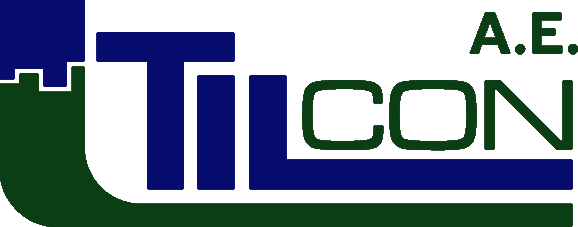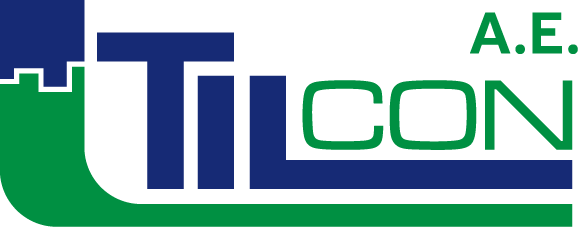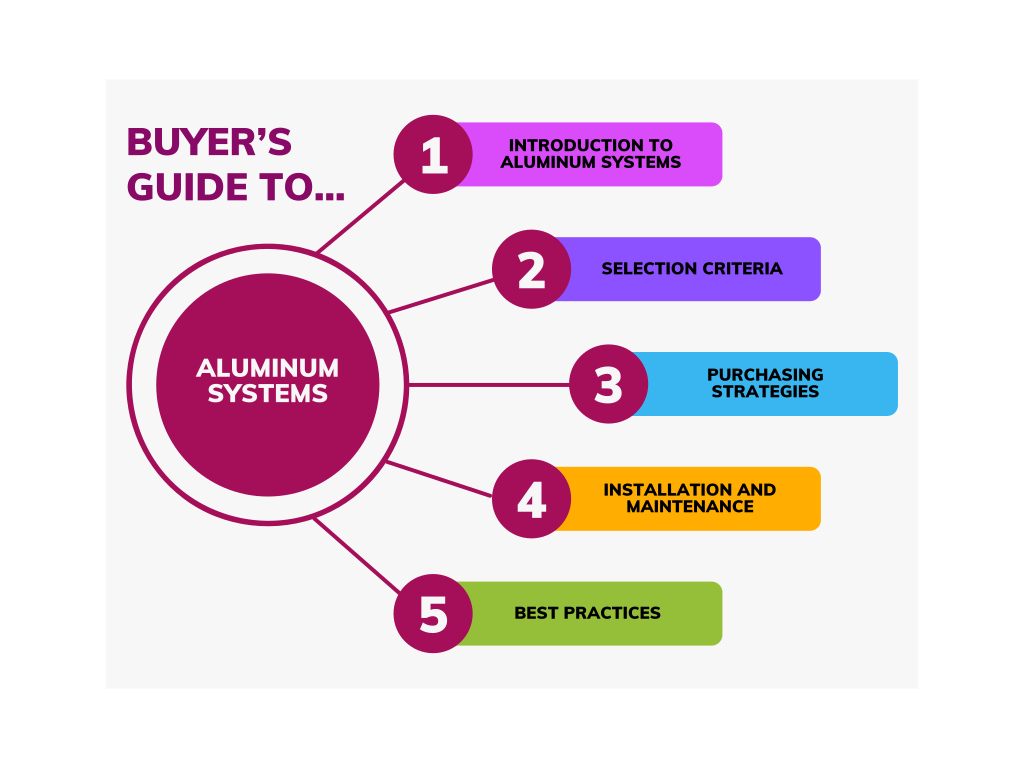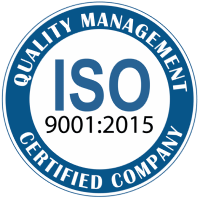-
Introduction to Commercial Aluminum Systems
1.1 Types of Aluminum Systems
Commercial aluminum systems provide architects and builders with dynamic solutions for enclosing and defining building spaces. Here’s a breakdown of the most common types:
Curtain Walls: These non-load-bearing systems create expansive glass facades. They offer excellent light transmission, thermal performance options, and a wide range of design possibilities. Curtain walls are common in high-rise office buildings, shopping malls, and other structures where visual appeal is important.
Storefronts: Aluminum storefronts are designed for ground-level applications, showcasing retail spaces and providing welcoming entrances. They emphasize durability, visual appeal, and ease of customization to fit brand aesthetics.
Doors and Windows: Commercial aluminum doors and windows are known for their strength, energy efficiency, and ability to withstand harsh weather conditions. They can be integrated into curtain walls and storefronts or used as standalone elements.
Specialized Systems: Aluminum systems cater to specific niche requirements as well. Examples include blast-resistant systems for high-security buildings, hurricane-resistant systems for coastal areas, and thermally enhanced systems for optimizing energy efficiency.
At Tilcon SA, years of experience and know-how, combined with continuous research and development, make us one of the largest and most reliable manufacturers in Greece. you can click here to see some of the systems we manufacture: https://tilcon.gr/en/products/
1.2 Benefits of Using Aluminum in Construction
Aluminum stands out in the construction industry due to its remarkable combination of strength, lightweight, and resistance to corrosion. These intrinsic qualities make aluminum an increasingly popular choice for various construction applications, from skyscrapers to bridges.
Lightweight Nature: Aluminum’s low weight reduces the overall load on structures, facilitating larger spans and minimizing foundation requirements. This lightness also translates to reduced transportation and installation costs, making construction projects more economical.
Durability and Corrosion Resistance: Aluminum forms a natural oxide coating that protects it from corrosion. This property ensures a longer lifespan for aluminum structures even in harsh environmental conditions, thereby reducing maintenance costs and extending the economic life of projects.
Sustainability: As a sustainable choice, aluminum is 100% recyclable without loss of its natural qualities. Its use contributes to sustainable construction practices by minimizing environmental impact and reducing the carbon footprint of projects.
Cost-Effectiveness: Initially, aluminum might seem expensive; however, its durability and low maintenance requirements lead to significant long-term savings. This cost-effectiveness, combined with the material’s adaptability and aesthetic appeal, presents a compelling case for its use in construction.
These benefits not only enhance the operational efficiencies of construction projects but also contribute to their long-term success and sustainability.
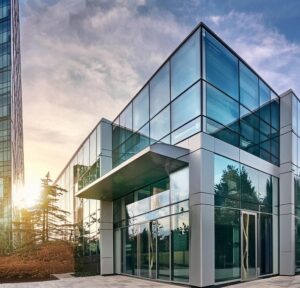
1.3 Historical Development and Technological Advances
The journey of aluminum in construction is a testament to innovation and adaptation. From its initial use in the 19th century, when it was more valuable than gold[1], to becoming a staple in modern architecture, aluminum’s development has been marked by significant technological breakthroughs[2].
Early Adoption: Initially used in high-profile projects like the Empire State Building’s iconic spire, aluminum quickly became known for its strength and lightness. This period was crucial in establishing aluminum as a viable material for large-scale constructions.
Technological Breakthroughs: Over the decades, advances in alloy technology and processing methods have expanded aluminum’s applications. Techniques such as extrusion and anodization have enhanced its structural capabilities and surface resilience, broadening its use in construction.
[1]https://clintonaluminum.com/aluminum-was-once-worth-more-than-gold-and-silver/
[2]https://www.npr.org/2019/12/05/785099705/aluminums-strange-journey-from-precious-metal-to-beer-can
Industry Standards and Innovations: The establishment of industry standards has been pivotal in ensuring quality and consistency in aluminum products. Today, cutting-edge applications, such as computer-aided design (CAD) and 3D printing, are setting new benchmarks for precision and efficiency in aluminum construction.
Future Trends: Looking forward, the push towards sustainable and smart construction practices is likely to see increased use of aluminum. Innovations in alloy composition and recycling processes are expected to further cement its role in eco-friendly construction solutions.
By understanding the historical context and anticipating future developments, the construction industry can better harness the full potential of aluminum to meet contemporary demands and future challenges.
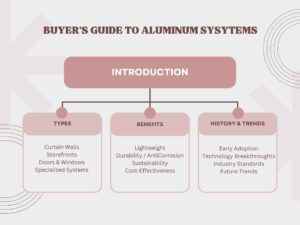
-
Selection Criteria
2.1 Assessing Quality and Durability
When selecting aluminum systems for construction projects, understanding the standards of quality and durability is crucial. This understanding ensures that the chosen materials will stand up to the environmental demands and operational requirements of the project.
Testing Standards: Key to assessing aluminum’s quality are industry-accepted testing standards such as American Society for Testing and Materials[1](ASTM International) and International Organization for Standardization (ISO)[2]. These standards evaluate properties like tensile strength, corrosion resistance, and fatigue limits. Compliance with these standards assures that the aluminum system is capable of performing under specified conditions.

Quality Control Measures: Manufacturers’ quality control processes are also vital to assess. These include regular inspections, batch testing of materials, and adherence to production standards. Such measures prevent defects and ensure that the final product maintains a consistent quality.
[2]https://en.wikipedia.org/wiki/International_Organization_for_Standardization
Certifications: Certifications like the Qualicoat[1] for coating quality or Qualanod[2] for anodizing quality provide additional assurance of a product’s durability and performance. These certifications[3] indicate that the product has undergone rigorous testing and meets higher standards of quality.
Practical Implications: For construction managers, understanding these standards and measures is not just about technical compliance but also about foreseeing the longevity and maintenance needs of the structure. High-quality aluminum systems contribute to reduced maintenance costs and extend the lifespan of the construction, providing long-term value.
By rigorously assessing the quality and durability of aluminum systems through these standards and controls, stakeholders can significantly mitigate risks and enhance the reliability of their construction projects.
At Tilcon, we are committed to the ongoing development of our quality assurance program, enhancing our production processes and products to meet European and international standards. Through this process, we maintain our competitive advantage, which, in many cases, is a prerequisite for cooperation and a criterion for the selection of our systems. We are ISO 9001: 2015 certified.
2.2 Cost Analysis: Initial vs. Long-Term Investment
Investing in aluminum systems involves a detailed analysis of both initial and long-term financial considerations. While the upfront costs can be significant, the long-term benefits often justify the initial investment.
Choosing a commercial aluminum system requires a forward-thinking approach to cost analysis.
Here’s how to factor in both initial investment and long-term financial implications:
Initial Investment: The upfront cost of an aluminum system includes:
-
- Material Costs: Prices can vary based on alloy type, system complexity, and profile size.
- Fabrication Costs: Consider the level of customization and fabrication processes required.
- Installation Costs: Factor in labor costs, site preparation, and required equipment.
Long-Term Costs and Savings Energy Efficiency:
Aluminum systems with thermal breaks and high-performance glazing contribute to reduced energy consumption for heating and cooling the building.
-
- Minimal Maintenance: Aluminum’s resistance to corrosion and weathering translates to lower maintenance and cleaning costs over time.
- Long Lifespan: With proper installation and care, aluminum systems can last for decades without requiring full replacement.
[1]https://www.qualicoat.net/main/about-us/assured-quality.html
[3]https://en.asandanismanlik.com/qualicoat-qualanod-certificate/

Financial Evaluation:
-
- Life Cycle Cost Analysis (LCCA): Comprehensive tools calculate total costs over the building’s lifespan, factoring in projected maintenance, repair, and replacement costs.
- Return on Investment (ROI): Evaluate potential energy savings and long-term value generated by investing in high-quality aluminum systems.
Understanding the true cost of ownership helps buyers make informed decisions that prioritize long-term value and minimize financial risk.
This cost analysis underscores the importance of considering bothimmediate and future financial impacts when selecting construction materials, with aluminum standing out as a financially viable option over the long term.
2.3 Evaluating Supplier Credentials and Reliability
Choosing a reliable and experienced supplier is essential for the successful execution of your commercial aluminum system project. Here’s how to thoroughly evaluate a supplier:
- Industry Accreditations: Look for suppliers who hold relevant certifications and affiliations with organizations like Fenestration and Glazing Industry Alliance[1] (FGIA) demonstrating adherence to industry standards and commitment to quality.
- Project Portfolio and Experience: Examine a supplier’s past projects. Pay attention to the scale, complexity, and types of projects they specialize in. Does their portfolio align with your project and demonstrate the required expertise?
- Client References: Speak to past clients and gather their feedback on the supplier’s performance, quality of work, responsiveness, and ability to meet deadlines.
- Production Capacity: Evaluate the supplier’s ability to handle your project scale and meet production deadlines.
- Lead Times: Consider typical lead times for materials and fabrication, ensuring they align with your project schedule.
- Responsiveness and Communication: Assess the supplier’s communication style and their willingness to address questions or concerns during the initial inquiry phase.
Proactive supplier evaluation helps mitigate risks and ensures a smooth project experience from design to installation.
-
Purchasing Strategies
3.1 Effective Budgeting Techniques
Establishing and maintaining a realistic budget is critical for ensuring the financial viability of your commercial aluminum system project.
Here’s how to create an effective budget:
- Cost Breakdown: Create a detailed breakdown of all cost components, including:
-
- Material Costs: Obtain accurate quotes from suppliers and factor in potential price fluctuations.
- Fabrication Costs: Account for customization, finishes, and associated labor costs.
- Installation Costs: Include labor, equipment, and site preparation expenses.
- Permitting and Fees: Consider any necessary permits and regulatory fees.
- Contingency Planning: Allocate a contingency fund (typically 5-10% of the total budget) to address unforeseen expenses, material price increases, or project delays.
- Budget Tracking: Implement tools to track expenditures against the budget. Regular budget reviews help identify potential cost overruns early and allow for corrective action.
By mastering these budgeting techniques, companies can minimize financial risks associated with aluminum systems procurement and ensure that projects are completed within the allocated budget, maximizing financial outcomes.

3.2 Negotiation Tactics with Suppliers
Negotiation is a crucial skill when purchasing commercial aluminum systems. Here’s how to approach negotiations strategically:
- Preparation is Key:
-
- Market Research: Gather information on typical pricing, industry trends, and competitor offerings.
- Define Your Goals: Establish clear objectives for pricing, lead times, warranties, and payment terms before entering negotiations.
- Prepare Opening Offer: Determine a realistic opening offer that leaves room for negotiation.
- Competitive Bidding:
-
- Request for Proposals (RFP): Develop a detailed RFP outlining project requirements and evaluation criteria.
- Solicit Multiple Bids: Obtain bids from at least three reputable suppliers to enhance your bargaining power.
- Analyze Bids Carefully: Thoroughly compare proposals, considering various cost components and contract terms.
- Contract Negotiation:
-
- Focus on Key Terms: Negotiate pricing, lead times, warranties, payment schedules, dispute resolution and scope of work.
- Aim for Win-Win: Look for mutually beneficial agreements. Suppliers who feel valued are more likely to provide exceptional service.
- Building Relationships:
-
- Open Communication: Establish clear communication channels with your chosen supplier.
- Foster Long-Term Partnerships: Successful negotiations lay the foundation for strong and lasting supplier relationships.
By mastering these negotiation tactics, procurement professionals can significantly enhance the terms on which they acquire aluminum systems, leading to cost savings and better project delivery.

3.3 Understanding and Managing Custom Orders
Custom-designed aluminum systems offer the freedom to create unique architectural solutions. Here’s what you need to know to successfully manage custom orders:
- Customization Possibilities:
-
- Profiles: Design bespoke extrusion profiles for unique shapes and functions.
- Finishes: Create distinctive visual effects with a wide array of colors, textures, and specialized coatings.
- Glazing: Integrate high-performance or unique glazing types for optimized energy efficiency, aesthetics, and acoustic properties.
- Hardware: Incorporate customized hardware solutions for specialized functions or aesthetics.
- Design Specifications and Documentation:
-
- Detailed Drawings: Provide suppliers with meticulous architectural drawings, clearly defining dimensions, tolerances, and assembly details.
- Technical Specifications: Outline performance requirements, testing standards, and material specifications.
- Lead Time Considerations:
-
- Longer lead times: Custom orders often require additional time for design, fabrication, and potential material sourcing.
- Early Planning: Factor in extended lead times during the project planning phase to avoid delays.
- Collaborating with Suppliers:
-
- Choose Experienced Suppliers: Select suppliers with a proven track record of successful custom projects and technical expertise.
- Clear Communication: Establish open communication channels with the supplier throughout the design and fabrication process.
- Request Prototypes (if needed): In complex bespoke designs, consider ordering prototypes for testing and design refinement.
By mastering these elements, project teams can successfully manage custom aluminum system orders, ensuring that the final product aligns perfectlywith the client’s vision and project requirements.
Section 4: Installation and Maintenance
4.1 Step-by-Step Installation Guide
Installing commercial aluminum systems requires precision, attention to detail, and adherence to specific protocols to ensure optimal performance and durability. Here’s a step-by-step guide to the installation process:
Site Preparation: Begin by preparing the installation site. This involves clearing the area of any debris, ensuring that the surface is level, and confirming that all measurements align with the project specifications.
Safety Protocols: Before commencing work, review all relevant safety protocols. Ensure that all personnel are equipped with necessary safety gear and understand the risks involved in the installation process.
Component Assembly: Assemble the aluminum system components according to the manufacturer’s instructions. This step often requires precise alignment and secure fastening of sections to ensure structural integrity.
System Installation: Lift and position the aluminum system onto the prepared site. Use cranes or other mechanical aids for larger structures to avoid manual handling injuries and ensure precise placement.
Final Inspection: Conduct a thorough inspection of the installed system. Check for any alignment issues, improper fittings, or areas that require additional sealing.
Quality Assurance: Document the installation process for quality assurance purposes. This record can help address any future concerns and facilitate maintenance work.
By following these steps, installation teams can ensure that commercial aluminumsystems are installed safely and effectively, ready to meet the demands of any construction project.
4.2 Routine Maintenance Recommendations
Regular maintenance ensures your commercial aluminum system continues to look and perform its best. Follow these guidelines:
- Cleaning Guidelines:
-
- Finish Considerations: Cleaning methods vary depending on the finish (anodized, painted, etc.). Refer to the manufacturer’s instructions for suitable products and techniques.
- Frequency: Clean the system periodically to remove dirt and environmental contaminants. Frequency depends on location and climate.
- Inspection Checklists
-
- Visual Inspections: Regularly examine the system for signs of damage, corrosion, sealant deterioration, and loose fasteners.
- Functional Checks: Test operation of windows, doors, and hardware. Ensure proper drainage of rainwater.
- Early Problem Detection: Watch for:
-
- Signs of Corrosion: Look for pitting, discoloration, or white powdery deposits on the surface.
- Sealant Issues: Check for cracks, peeling, or missing sealants around joints and penetrations.
- Hardware Malfunctions: Address problems with hinges, handles, or locking mechanisms.
- Preventive Measures:
-
- Keep Systems Clean: Regular cleaning prevents the buildup of harmful contaminants.
- Maintain Landscaping: Avoid plants or vines directly against the system to prevent moisture buildup.
- Address Issues Promptly: Minor repairs can prevent significant problems and costly interventions.
By following these maintenance recommendations, facility managers and maintenance teams can ensure that aluminum systems continue tofunction effectively and look their best, contributing to the overall value and safety of the property.
Proactive maintenance maximizes the longevity of your aluminum systempreserving your investment.
4.3 Troubleshooting Common Issues
Maintaining commercial aluminum systems often involves addressing various operational and structural issues that can arise due to environmental factors, usage patterns, or material fatigue.
Even well-maintained commercial aluminum systems may occasionally develop problems.
Here’s how to address common concerns:
- Water Leaks
-
- Investigate: Identify the source of the leak (joints, sealants, cracks, etc.).
- Potential Solutions: Reapply sealants, replace damaged weatherstripping, or address underlying structural issues.
- Operational Issues (Windows & Doors)
-
- Sticking or Difficulty Operating: Lubricate hinges and tracks, inspect for warping or damaged components.
- Hardware Malfunctions: Check for loose screws, broken parts, or alignment issues and replace components as needed.
- Surface Deterioration
-
- Minor Scratches: Touch up with suitable repair products (consult with your system manufacturer).
- Chalking or Fading: Consider professional cleaning or refinishing options for extensive damage.
- Knowing Your Limits: For complex repairs, structural issues, or if troubleshooting fails, call in a qualified technician.
By effectively diagnosing and addressing these common issues, maintenance teams can extend the lifespan of aluminum systems, improve their functionality, and maintain their aesthetic appeal.
-
Lessons Learned and Best Practices
Years of experience with successful commercial aluminum system projects have revealed key success factors:
- Communication is Key
-
- Engage Early: Consult with system manufacturers during the design phase for technical advice and feasibility.
- Open Dialogue: Maintain open channels of communication with installers throughout the process to address questions and coordinate details.
- Early Planning and Coordination
-
- Lead Times: Understand lead times for system fabrication and delivery. Factor them into the project schedule.
- Site Preparation: Plan for precise site readiness to avoid installation delays.
- Coordination with Other Trades: Ensure seamless integration of aluminum systems with adjacent building components and systems.
- Attention to Detail
-
- Thorough Specifications: Provide clear and detailed specifications for system performance, finishes, hardware, and integration with other systems.
- Shop Drawing Review: Carefully review manufacturer’s shop drawings for accuracy and compliance with design intent.
- Quality Control: Regularly conduct on-site inspections throughout the installation process.
- Anticipate and Adapt
-
- Expect the Unexpected: Despite meticulous planning, be prepared for unforeseen issues or changes.
- Collaborative Problem-Solving: Work proactively with all parties to find solutions and avoid costly delays.
Industry Expert Advice:
“Successful aluminum system projects rely on clear communication, thorough specifications, and a focus on quality throughout the entire process.” – Experienced Project Architect.
By adopting these best practices, you increase the likelihood of a smooth and successful commercial aluminum system project.
